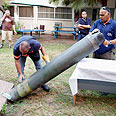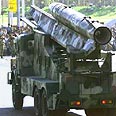

In addition, a senior government source told Reuters that the IDF destroyed two thirds of Hizbullah's Zelzal missiles.
Figures for the short-term rockets are less encouraging, however. Hizbullah still holds 10,000 such rockets.
Almost three weeks have passed since the start of fighting in the north, and the IDF has identified a certain difficulty among Hizbullah members in launching medium-range rockets. With that, however, Hizbullah's short-term rocket capability has not been significantly damaged.
Three weeks ago, Hizbullah had 13,000 short-term rockets. After firing 1,500 rockets Israel, and additional 1,500 destroyed by the IDF, the organization still has 10,000 rockets that can reach the frontline. The rockets have a diameter of 107 and 122 millimeters.
These rockets' ability to cause damage is relatively limited, as they can carry only seven kilograms of explosives.
In this category, the IDF's strike has not been significant as the rockets are fired from many areas and still exist in high numbers. With that, they reach a range of the front line alone and cannot reach Haifa and the Krayot area.
The main objectives obtained by the IDF are the taking out of many medium-range rockets, which are divided into four categories:
- The improved 122 rocket (a normal rocket that has been upgraded and can reach a range of 40 kilometers, or 25 miles).
- Fajr 3 (A rocket with a 43-kilometer range, or 27 miles).
- The 220 millimeter rocket (with a range of 70 kilometers, or 43 miles).
- Syrian rockets with a diameter of 302 millimeter, such as the type fired at Afula last weekend, and which reach between 90 (56 miles) and 115 kilometers (71 miles).
Almost no Fajr-type rockets have been fired after that system was significantly attacked on the first night of operations.
The IDF believes that Hizbullah has an operational problem in activating the system.
Main problem is the 122 millimeter rocket
On the other hand, the 220 millimeter rocket system has caused most of the casualties in Haifa and the surrounding regions.
According to estimations, the rocket launchers of this system have been struck, and the proof is the reduction in the number of rockets fired of this type, thereby explaining the relative calm in Haifa.
The last firing of rockets from this system was on July 27 at Carmiel. They were launched north of the Litani river apparently because the terrorists were shoved northwards by IDF operations.
It is believed that Hizbullah is in possession of a number of 220 millimeter rockets, but the number of such rockets has dropped dramatically by half, from 400 to 200. The IDF believes that the organization has dozens of Fajr 3 rocket left, alongside lone launchers.
The figures in effect point to Hizbullah's difficulties in all that is related to the medium-range rockets. It seems most of the arsenal has been destroyed or already fired at Israel.
The IDF believes there is an attempt to transfer rockets and missiles from Syria to Lebanon, in order to replenish the weapons supply.
The IDF's main problem is the 122 millimeter rocket. It is believed Hizbullah has between 9,000 to 10,000 rockets that reach Haifa and frontline communities, but they are fired from a more distance place.
It is believed that Hizbullah members received an order to fire between 100 and 120 'normal' rockets a day. On Monday for example, 157 such rockets were fired, a fifth of them fired north of the Litani River, a fact which testifies to the difficulties of the rocket launchers targeting Israel.















